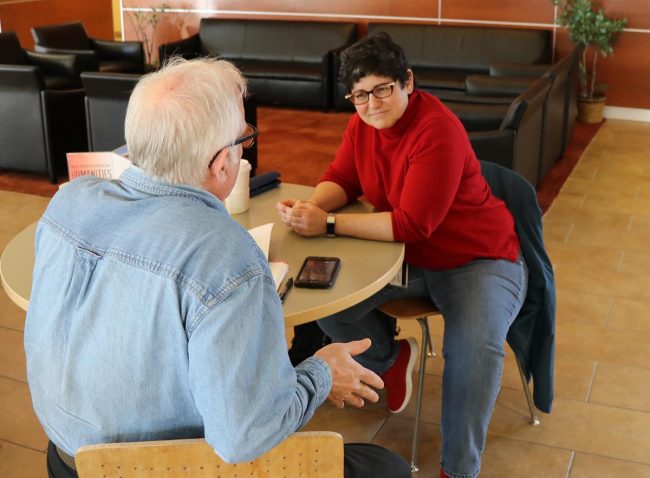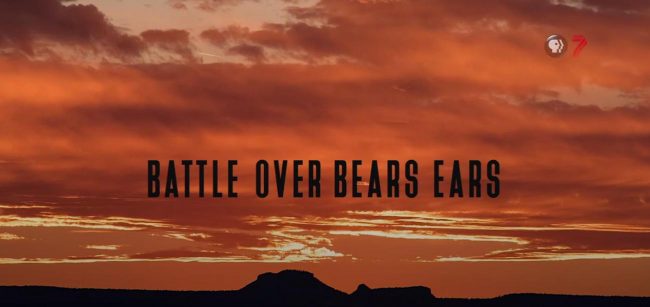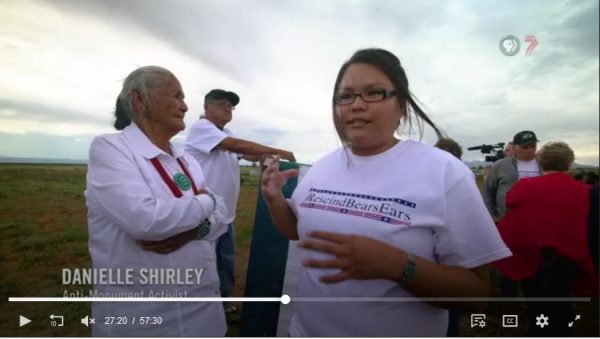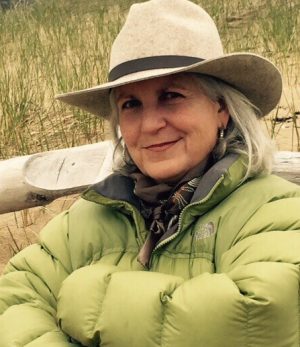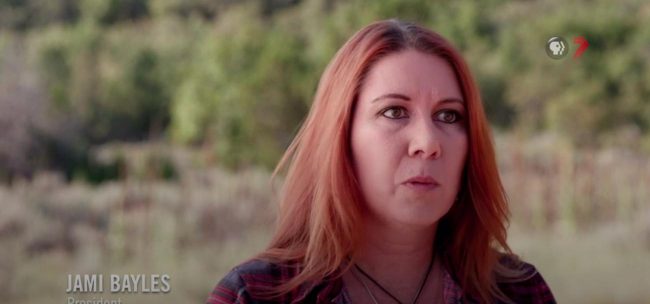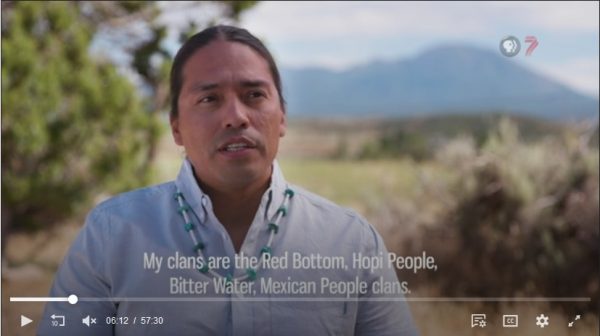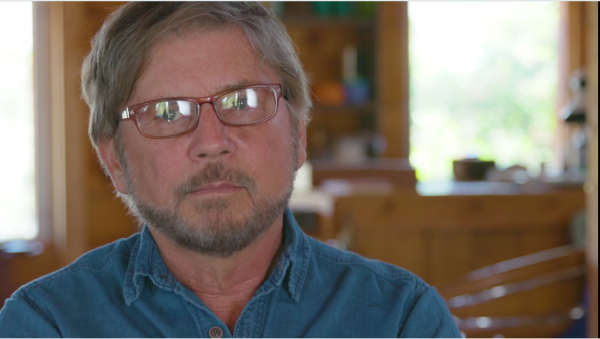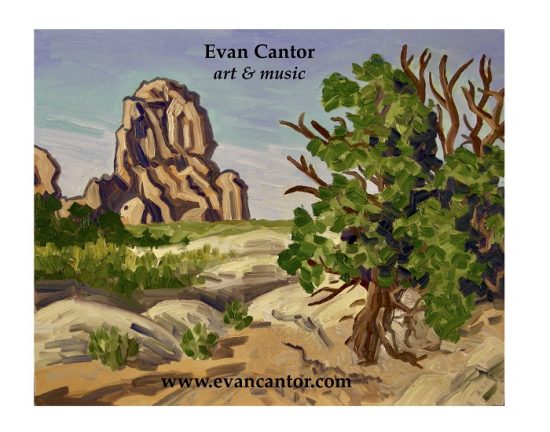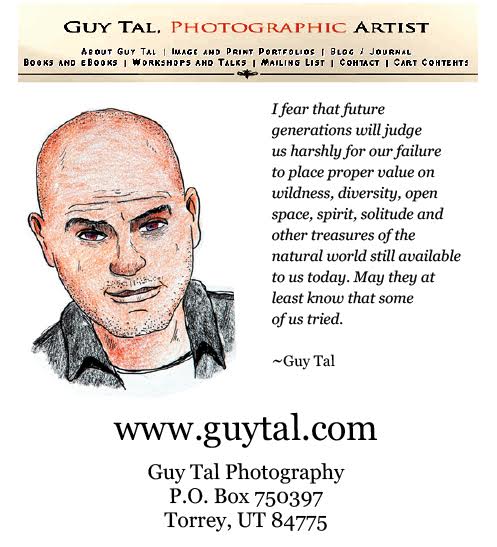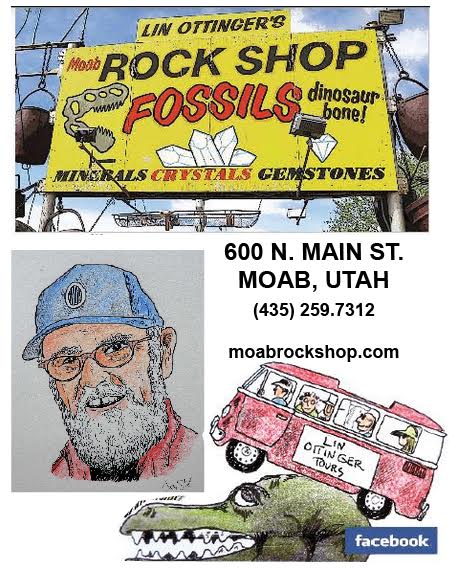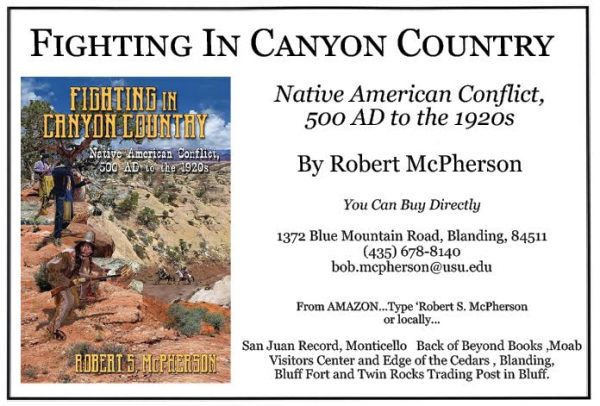“Battle Over Bears Ears” is a one-hour documentary produced by KUED in Salt Lake City. According to the station’s website, it “explores the deep connections to place and the vast cultural divides that are fueling the fight over how the Bears Ears Monument is protected and managed. Whose voices are heard, whose are lost, and how do all sides find common ground in this uncommon place?” Watch it here.
The film was produced by Nancy Green, who specializes in the production of documentaries for local, regional and national PBS broadcast. Her work at KUED spans nearly 25 years, focusing on diverse topics, including health care, the arts, history and the outdoors. Recent films include “Homeless at the End,” “Search and Rescue,” “The Utah Bucket List,” “Maynard Dixon to the Desert Again” and “On the Edge: Mental Health in Utah.”
Green has won numerous awards over the course of her career, including awards from the Rocky Mountain Emmys, Utah Society of Professional Journalists, Houston WorldFest, National CINE Golden Eagle, New York Film Festivals and Women in Television & Film.
The interview was conducted Nov. 16 on the University of Utah campus. It has been edited for clarity, context and coherent structure. Questions and responses have been paraphrased. And where I felt the conversation needed extra context, I’ve added postscripts in italics.
ZEPHYR/BILL KESHLEAR: Thanks for sitting down with me to talk about the film and other things. Congratulations on the “Battle Over Bears Ears.” As far as I can tell no other media outlet has devoted as much of its resources to covering this complicated, intensely personal and politically significant story as your KUED production.
The film gives voice to several marginalized voices that have been either omitted or consciously edited out of similar reports – even by some of the most prestigious news organizations in the country, including CNN and the PBS “NewsHour,” as the Zephyr has reported.
NANCY GREEN: I dove into some very deep waters on this one.
Z/KESHLEAR: Tell us a bit about the process of identifying credible sources of information and persuading them to answer tough questions on the record.
GREEN: First we wanted to identify voices in the debate. Jim Stiles (editor of the Zephyr) has written extensively on the topic. Jami Bayles was another. We met with people who knew us and had common interests. It was hard to get Native Americans who were critical of monument designation. We talked off-camera to a lot of people. Tensions were high. Logistics posed challenges. And some people, frankly, were just tired of Bears Ears politics.
I would meet people and that would be an entrée to meet other people. Building connections one person at a time. They didn’t always trust me because they didn’t trust the media but they took a chance.
Z/KESHLEAR: What surprised you about the residents of San Juan County, both for and against the monument?
GREEN: There’s a deep love of the place among residents of San Juan County – almost at a cellular level.
Z/KESHLEAR: What were the untold stories that you attempted to tell? Did you succeed?
Green: There were just too many untold stories to truly succeed. But I think just trying to understand the worldviews of other people a little more was important. So much is personal and there were complex layers of history. I think I hinted at that but didn’t really succeed.
I felt like some of the anti-monument views had not been heard in previous media accounts. Jami Bayles (president of the grass-roots nonprofit Stewards of San Juan) grew up there. She talked about deep memories of place. She learned to hunt in the Bears Ears region. There were regular campouts with her family. Events that shaped who she is are connected to the landscape. Those were views, as an urbanite, I had not really thought about.
And Danielle Shirley – Dine and against the monument. It makes sense: Why would a Native American trust the government after decades of broken promises. She conveyed the notion that there’s so much need in the region and so much poverty; so much good that could be done with the energy and money that’s being spent to protect the landscape. Hers was a voice that had not been heard.
The notion of different worldviews hasn’t really been explored by mainstream media. For example, many in one group have a non-Western orientation of time and place. It’s part of the problem in resolving the conflict over Bears Ears.
People were not only talking at each other, they were talking past each other.
Z/KESHLEAR: On top of all that is the “elephant in the room.” There’s been a high-level, behind-the-scenes political and environmental effort to safeguard the Antiquities Act, according to Tommy Beaudreau, former Interior Secretary Sally Jewell’s chief of staff, speaking at a seminar held at Johns Hopkins University in April.
It included southeastern Utah monument activists Willie Grayeyes, elected San Juan County commissioner in November, and Josh Ewing, director of Friends of Cedar Mesa, sources in KUED’s movie, but excluded Utahns who might prefer alternatives.
(Post-script: President Donald Trump’s proclamations last year dramatically shrunk Bears Ears and Grand Staircase-Escalante national monuments. Environmentalists considered the actions a bald-faced attack on the foundations that helped create the National Park system, the Antiquities Act, and they’re pulling out all the stops to reverse the actions.)
“The conventional narrative is about how the monument was designated and then came Trump,” said Utah resident Stacy Young. “But that actually gets the order of events backward: Trump was already president-elect when the designation was made.
So, the Obama administration made the monument designation knowing full well that, at best, it wouldn’t be implemented. In fact, they knew it would result in a huge fight; that the fight would be protracted and its outcome uncertain.”
The Obama administration knew that it would draw attention to the area, possibly accelerating destruction of its fragile landscape and artifacts of early human habitation. They did it anyway.
Bears Ears represents their most “sympathetic plaintiff” in the legal fight over the Antiquities Act, Beaudreau said.
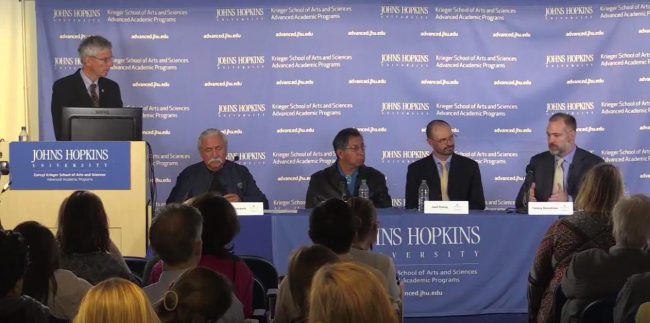
Seated are Bears Ears activists Willie Grayeyes, left, elected San Juan County commissioner in November, and Josh Ewing, third from left, director of Friends of Cedar Mesa. Tommy Beaudreau, former Interior Secretary Sally Jewell’s chief of staff, is at the right.
Beaudreau says in the video that the boundary of Obama’s monument echoes what San Juan County’s Lands Council came up with through an 18-month public process. “We tried to hew to the PLI (Lands Council’s) proposal. We couldn’t argue with a straight face that there wasn’t consensus about the area.” The quote comes at 58:20 in the video.
GREEN: People talk about the Council. People really did sit across from each other. There was real negotiation happening. People might say it didn’t go far enough or it wasn’t terribly realistic. But it was at least a process that was started and could’ve been built into something.
Z/KESHLEAR: Larger forces were at play.
GREEN: With the PLI, no one felt that they were heard.
Z/KESHLEAR: THE version that appeared in the bill Bishop introduced into Congress included significant changes not discussed by the Council or presented at town halls held across the county. For example, Recapture Canyon – the site where in 2014 San Juan County Commissioner Phil Lyman led an illegal all-terrain vehicle ride in violation of the Bureau of Land Management’s prohibition on motorized travel – would’ve been opened. Buried deep in the legislation was approval of a right-of-way request from San Juan County to reopen the canyon to motorized travel. Lyman was chair of the Lands Council at the time.
(Post-script: A remarkable letter letter written in 2014 by Terry Tempest Williams, a prominent author, doyen of environmentalism and board member of Southern Utah Wilderness Alliance, published in her “The Hour of Land” documents a budding alliance of environmental and tribal activists. A who’s who of Utah and regional environmentalists and representatives of the pro-monument activist nonprofit Utah Dine Bikeyah convened private meetings at Williams’ home in Castle Valley, about 20 miles east of Moab. They coincided roughly with deliberations of at least one big environmentally oriented nonprofit, the Conservation Lands Foundation, to join the tribal campaign and, in effect, pull out of public efforts of the San Juan County Public Lands Council, a citizens’ group tasked by Rep. Rob Bishop, R-Utah District 1, to come up with a plan to manage public land in the area. The Council comprised a 14-member work group representing a range of interests. It considered several proposals at county commission meetings and a half dozen open houses in the county and came up with a practical compromise: a mix of energy-development areas, national conservation areas and designated wilderness. It closely resembled Obama’s eventual proclamation.)
Z/KESHLEAR: Backseat driving I know but I am thinking about alternatives to the “Trump and his oil-and-gas buddies vs. Native Americans protecting their sacred ancestral lands” narrative that’s been told over and over. Perhaps an all-Navajo perspective with Blue Mountain Dine or Descendants of K’aayelii as protagonists? Blue Mountain Dine, many of whom live outside the Navajo reservation in San Juan County, oppose President Obama’s Bears Ears National Monument while the K’aayeliis have taken no position on it but opposed Rep. Bishop’s Public Lands Initiative. They’re the two San Juan County indigenous groups whose ancestors were most closely connected to Bears Ears.
GREEN: I wished I had been able to contact the K’aayeliis. That would’ve been fascinating.
(Post-script: Almost every Navajo family has passed down stories about the horrors of the Long Walk, the 1864 deportation of about 8,000 Navajos and Mescalero Apaches to a desolate stretch of eastern New Mexico. It was what today we’d call “ethnic cleansing.” There were many Navajos, however, who never went to Fort Sumner. Followers of K’aayelii, a principal headman likely born near Elk Ridge north of Bear’s Ears, spent their lives in southeastern Utah. K’aayelii’s descendants still tell with pride stories about how he and his people never surrendered.
(The later story of the K’aayeliis fierce independence and removal from Bears Ears to the Aneth extension of the Navajo Reservation in the 20th century has not been told. In a Sept. 22, 2016, resolution, they opposed Bishop’s PLI and took no position on Obama’s monument because “of being excluded from the consultation process.” The K’aayeliis’ resolution goes on to assert, “we speak for ourselves and we ask that others not speak on our behalf.”)
Z/KESHLEAR: Theirs would’ve been a David and Goliath story.
GREEN: Who is David? Who is Goliath?
Z/KESHLEAR: Stewards of San Juan, Jami Bayles’ group …
GREEN: She got some funding from the Sutherland Institute.
Z/KESHLEAR: I think that’s a common perception among many monument backers.
(Postscript: But it’s not true, according to Bayles: “From day one, the Stewards of San Juan has always been a grass roots organization that relied mostly on its own dedication and hard work.
“We made our own signs, designed our own T-shirts and stickers and we put together our own fund-raising events and rallies. Not one board member is paid to be a part of SOS. We’re not even designated a nonprofit organization because we never generated enough revenue to go through the process of becoming one.
“Sutherland Institute contributed $500 last year to be a sponsor of an event called the San Juan Freedom Fest that SOS was organizing, and that was all it gave. However, our counterpart, Utah Dine Bikeyah, has done extraordinarily well because of outside funding and support to advance its cause.
“According to IRS documents, UDB had $7,000 in net assets in 2014. Just two years later, those assets had increased to $660,541. Patagonia and the Conservation Lands Foundation contributed $59,500 and $254,000, respectively, to UDB between 2014-2016.”)
Except for the 2014 memo from Conservation Lands Trust that documented its support of tribal efforts to create a national monument, the “elephant in the room” – a coalition of environmental nonprofits and tourism and outdoor recreation-oriented businesses that have funded creation and now litigation of Bears Ears National Monument – was largely missing from the film.
GREEN: There were so many voices, it was really difficult. I used Peter Metcalf (a pro-monument businessman who sells outdoor recreation equipment) to address that.
(Post-script: A former member of the Bears Ears Inter-tribal Coalition and board members and paid staff of Utah Dine Bikeyah comprise the only pro-monument Native American voices in the film. UDB is led by Navajo and Ute Mountain Ute tribal members and has aligned itself with companies that promote and profit from non-motorized outdoor recreation. They include some of the nation’s most prominent and politically aggressive: Patagonia, The North Face, REI Co-op, Black Diamond, Arc’teryx, Sage, OR, küat, Osprey, Yakima, Clif Bar and Mountain Hard Wear.
(The organization is a beneficiary, directly or indirectly, of a sophisticated multimillion dollar, multiyear national campaign organized and administered by professionals who make a comfortable living off of creating and now litigating Bears Ears.
(Some of the biggest environmental and cultural foundations in the United States – the William and Flora Hewlett Foundation, Wyss Foundation, the Leonardo DiCaprio Foundation, the David and Lucile Packard Foundation, the Wilburforce Foundation, and the Grand Canyon Trust – have contributed to the campaign, including $1.5 million just after the Bears Ears region was designated a monument, in order to establish the Bears Ears Community Engagement Fund. Artplace gave UDB $400,000 “to promote a sustainable economic future in San Juan County, UT through culture, community, and the arts.”)
Z/KESHLEAR: Can our current system of representative government solve problems like this? Are private interests with well-financed agendas so powerful that they’ll inevitably mute citizen voices?
GREEN: I think that’s one of the frustrating things about this. There were many higher-level, politically and financially driven interests inside of this conversation. It does make you wonder about whose voice gets heard. And that drives the further question: What does it mean to have your voice heard? If you don’t get your way does that mean you’re not heard? That’s difficult to answer.
Z/KESHLEAR: Angelo Baca (staff member of Utah Dine Bikeyah and graduate student at New York University) is articulate on Navajo history, culture and spirituality. On the other hand, the first language of Willie Grayeyes is Navajo, and he might be somewhat limited in his ability to describe Navajo culture in English.
GREEN: I ran into that. It’s a difficult thing when you’re dealing with the media. The documentary was not filmed in the Navajo language. It creates a barrier. I spent a lot of time with Jonah Yellowman (board member of Utah Dine Bikeyah and spiritual adviser). I finally had to have him talk about Bears Ears in Navajo because it was his first language.
Z/KESHLEAR: There were sequences in the film related to former Interior Secretary Sally Jewell’s visit to the area in 2016, about the time Hillary Clinton locked up the Democratic Party’s nomination for president. How did the direction of “Battle Over Bears Ears” change because she didn’t go on to win the election?
GREEN: The Native American voices would not have been different. The divisiveness perhaps would not have been as sharp. Perhaps the film would’ve focused on the monument and its management.
Z/KESHLEAR: Much of the filming occurred in 2017 when the Trump administration was re-evaluating not only Bears Ears National Monument but the Antiquities Act itself. Status of the monument was in limbo – as it still is because of litigation to reverse Trump’s decision to shrink it. Obama’s monument existed in name only, and even as written it didn’t include anything that would’ve created real If Clinton had won, the monument’s management plan likely would’ve been written by now. San Juan County residents and monument activists could’ve pushed for provisions to beef up law enforcement. .
GREEN: If I could’ve put one more thing in the film … Bears Ears really needs law enforcement and funding. Back in the 1970s and ‘80s, BLM had something like eight or nine rangers, some patrolling with helicopters.
(Post-script: A bill introduced into Congress by Rep. John Curtis, R-Utah District 2, would increase the law enforcement presence within the modified Bears Ears boundaries. The bill also organizes an archaeological protection unit to assist law enforcement in understanding what areas to protect. Obama’s monument does neither. Representatives of the Bears Ears Inter-tribal Coalition have been critical of the measure, saying there was no consultation with the Native American community in the bill’s creation. The measure is likely dead because it has virtually no support from Democrats, who will take control of the U.S House of Representatives in January.)
GREEN: Don Simonis, an archeologist who has worked for the Bureau of Land Management, was quoted in the film. He supports the monument because it could provide a possible structure that could fund law enforcement.
Z/KESHLEAR: Yet aggressive law enforcement of 30 years ago was authorized by the Archeological Recovery and Protection Act of 1979 and possibly other laws enacted specifically to beef up a toothless Antiquities Act that had been used to create national monuments. Those rangers in helicopters didn’t need monument designation to go after looters and grave robbers.
(Post-script: Given political gridlock in Washington, D.C., it’s an open question whether the Interior Department has the wherewithal to operate and maintain a monument of the size and complexity of Bears Ears. Jon Jarvis, Obama’s director of the National Park Service, who oversaw creation of almost two dozen additional NPS units during his tenure, said he regrets that he was not able to secure adequate funding to protect and maintain those units or the rest of the system. Jarvis made the comments while speaking at the University of Utah in October.)
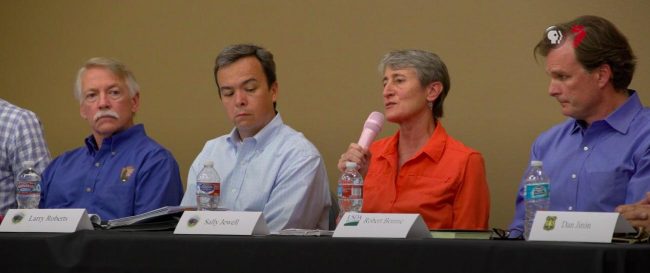
Jon Jarvis, left, President Obama’s director of the National Park Service, with Sally Jewell, Interior secretary, during a panel discussion in Blanding in 2016.
Z/KESHLEAR: What couldn’t you do because of the format?
GREEN: There’s just too much to condense into an hour. “Battle Over Bears Ears” barely scratches the surface. Maybe a 10-part podcast. Or a book. We have a website that looks further into it. We’re adding collateral material to it. We’ve linked to other resources – not necessarily political resources – on how to visit the area respectfully.
GREEN: There are false narratives. But you sort of drill down and figure it out.
Z/ KESHLEAR: When Outdoor Retailer (formerly of Salt Lake City) and Snow Shows debuted in January, industry leaders and environmental groups projected on the side of a downtown building a doomsday-style clock. It depicted time remaining before oil, gas and mineral leases would become available in the public lands targeted by Trump. It painted a picture of an unrestrained drilling bonanza, apparently intended to whip up a frenzy among “tree huggers, bunny lovers and rock lickers” (Utah Rep. Mike Noel’s irresistible coinage).
The hubbub over mining claims was part and parcel of “sky is falling” bombast.
“Trump raids national treasures.”
“Salt Lake County is out in force to protest the destruction of our public lands.”
“This is a shameful and illegal attack on our nation’s protected lands.”
“This unprecedented perversion of the Antiquities Act is a national stain.”
Although “perversion” and “national stain” are pretty darn good, my favorite comes from the marketing juggernaut, Patagonia, Inc.: “The president stole your land.”
Much of the pro-monument argument rests on the bogey of oil and gas development. It’s echoed ad nauseum by pro-monument nonprofits and Democratic partisans. Your film showed part of Utah state Rep. Patrice Arent’s speech at the Utah Dine Bikeyah rally last year on the steps of the Utah Capitol doing exactly that. Ewing of the Friends of Cedar Mesa picked up the theme standing in front of a pump jack.
GREEN: We had Jami talking about how development hasn’t happened and probably never will. Jim Stiles talked about it. We had Martin Vanden Berg from the Utah Geological Survey saying there’s really not much potential there. Three voices to one saying there’s not much there. I hope that dispels some of the misconceptions.
Z/KESHLEAR: The notion of Bears Ears as a place of healing was a common theme among Native American activists. It was clearly articulated in the film by Angelo Baca.
GREEN: With Angelo Baca, there seems to be a sense that conflict must precede healing.
Z/KESHLEAR: His comments seem at odds with those of Shaun Chapoose, a Ute leader, and Mark Maryboy, a longtime Utah Dine Bikeyah board member and activist. Over the past months and years comments from Shapoose, Maryboy and other pro-monument Native American leaders have been vicious, just shy of racist and misogynistic. But even the era of #metoo, they’ve gone unnoticed.
(Post-script: In a Facebook post dated Feb. 28, 2017, a commenter identified as Kenneth Maryboy referred to fellow tribal members who are political opponents as “tame Indians.” Much of the vitriol has been directed at anti-monument Democrat Rebecca Benally, who lost a bid for re-election as San Juan County commissioner to Maryboy in November.
(Virgil Johnson, chairman of the Confederated Tribes of the Goshute and president of the Utah Tribal Leaders Association, referred to Benally as a “token” Navajo at a Jan. 23, 2018, public forum sponsored by the environmental group Utah Valley Earth Forum in Orem, Utah. He repeated a line of personal attack directed at Benally by Shawn Chapoose, co-chairman of the Bears Ears Inter-tribal Coalition and chairman of the Ute Indian Tribe Business Committee, at a congressional hearing in Washington, D.C., several weeks earlier.
(On Jan. 6, 2018, The Salt Lake Tribune published an op-ed by Garon Coriz, a Santo Domingo (N.M) Pueblo and physician living in Richfield, Utah, with a headline likely written by a Tribune editor that referred to anti-monument Navajos, including Benally, as “window dressing” in service of Trump’s agenda. “Ultimately, Benally and her clique are the hammer and chisel in the state’s efforts to chip away at tribal sovereignty. … In Indian Country, with the history of individual tribal members sometimes betraying their tribes for a handout or payoff, she has become a pariah.” Coriz resurrected “Uncle Tom.” Among African Americans, there’s probably no insult more inflammatory.
(Then there’s this: Last year, Dave Skinner, a columnist for Range, published a sidebar about a 2014 email from Dennis Sizemore, executive director of Round River Conservation Studies, a key UDB ally, to an article titled “Monumental Megabucks: White billionaires, brown Astroturf, green monuments. Any questions?” It was an account of events at a meeting of Utah Diné Bikéyah. According to Skinner, the private message was sent to outsiders by UDB board member Mark Maryboy. Arch foe Phil Lyman, San Juan County commissioner, got hold of it and passed it along. The intended recipients comprise a “who’s who in white environmental leadership,” according to Skinner. They included Packard Foundation’s Sam Tucker, Hewlett Foundation’s Michael Scott, Pew Charitable Trusts’ Mike Matz, Conservation Lands Foundation’s Brian O’Donnell and others. “Sizemore’s email is clearly intended as internal damage control and paycheck protection,” Skinner wrote, “a communication among friends where everyone is on a first-name basis needing no further clarification: ‘[Mark Maryboy, a source in the film called me a racist and I pointed out that his head has been up a white man’s ass his whole career. It was downhill from there.’ “)
Z/KESHLEAR: Did you talk to anyone with a plan to bring people together?
GREEN: I never got the sense there was an actual plan. Perhaps a couple of years ago, common ground could’ve been found. But at this point in the discussion, I think the level of personal injury has made it extremely difficult.
Z/KESHLEAR: Who or what so far has “won” or “lost”?
GREEN: The landscape has been a loser. There needs to be some kind of management, some kind of cohesive vision whatever that might look like. To me, that’s the biggest tragedy.
SOURCES OF “BATTLE OF BEARS EARS”
Anti-monument
- Jami Bayles, Stewards of San Juan, president
- Danielle Shirley, Navajo, San Juan County
- The Johnson ranching family, San Juan County
- Phil Lyman, San Juan County, commissioner
- On tape: Utah Speaker of the House Rep. Greg Hughes; Utah Gov. Gary Herbert; San Juan County commissioner Rebecca Benally
Journalists
- Jim Stiles, editor and co-publisher, Canyon Country Zephyr
- Bill Boyle, publisher and former editor, San Juan County Record
Geologist
- Martin Vanden Berg, Utah Geological Survey
Pro-monument
- Utah Dine Bikeyah: Willie Grayeyes, chair; Mark Maryboy, board member; Angelo Baca, staff
- Regina Lopez-Whiteskunk, former member, Bears Ears Inter-tribal Coalition
- Sally Jewell, former Interior Secretary
- Peter Metcalf, founder, Black Diamond
- Josh Ewing, executive director, Friends of Cedar Mesa
- Don Simonis, archeologist
(Bill Keshlear regularly contributes to the Canyon Country Zephyr. He was an editor at The Salt Lake Tribune until taking a job as communication director for the Utah Democratic Party in 2007 and 2008.)
To comment, scroll to the bottom of the page.
Don’t forget the Zephyr ads! All links are hot!

